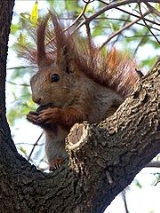
List of mammals of Austria
Encyclopedia
This is a list of the mammal species recorded in Austria. There are 81 mammal species in Austria
, of which 0 are critically endangered, 1 is endangered, 5 are vulnerable, and 3 are near-threatened.
The following tags are used to highlight each species' conservation status as assessed by the IUCN
:
Some species were assessed using an earlier set of criteria. Species assessed using this system have the following instead of Near Threatened and Least Concern categories:
Order: Rodent
----

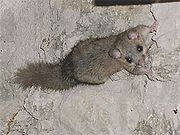
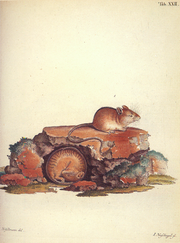

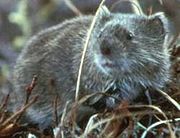

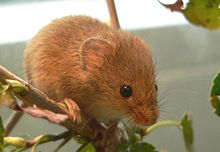 Rodents make up the largest order of mammals, with over 40 percent of mammalian species. They have two incisor
Rodents make up the largest order of mammals, with over 40 percent of mammalian species. They have two incisor
s in the upper and lower jaw which grow continually and must be kept short by gnawing. Most rodents are small though the capybara
can weigh up to 45 kg (100 lb).
Order: Lagomorpha
----
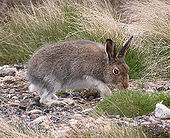 The lagomorphs comprise two families, Leporidae
The lagomorphs comprise two families, Leporidae
(hare
s and rabbit
s), and Ochotonidae (pika
s). Though they can resemble rodent
s, and were classified as a superfamily
in that order until the early 20th century, they have since been considered a separate order. They differ from rodents in a number of physical characteristics, such as having four incisors in the upper jaw rather than two.
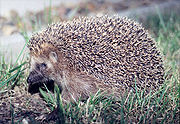 The order Erinaceomorpha contains a single family, Erinaceidae, which comprise the hedgehog
The order Erinaceomorpha contains a single family, Erinaceidae, which comprise the hedgehog
s and gymnure
s. The hedgehogs are easily recognised by their spines while gymnures look more like large rats.
Order: Soricomorpha
----
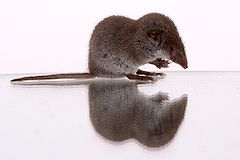
 The "shrew-forms" are insectivorous mammals. The shrews and soledons closely resemble mice while the moles are stout bodied burrowers.
The "shrew-forms" are insectivorous mammals. The shrews and soledons closely resemble mice while the moles are stout bodied burrowers.

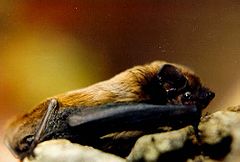
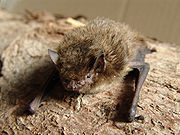
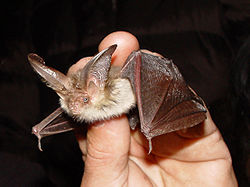 The bats' most distinguishing feature is that their forelimbs are developed as wings, making them the only mammals in the world naturally capable of flight. Bat species account for about 20% of all mammals.
The bats' most distinguishing feature is that their forelimbs are developed as wings, making them the only mammals in the world naturally capable of flight. Bat species account for about 20% of all mammals.
Order: Carnivora
----
.jpg) There are over 260 species of carnivorans, the majority of which feed primarily on meat. They have a characteristic skull shape and dentition.
There are over 260 species of carnivorans, the majority of which feed primarily on meat. They have a characteristic skull shape and dentition.
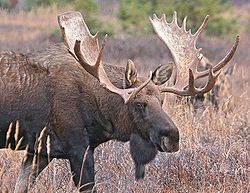 The even-toed ungulates are ungulate
The even-toed ungulates are ungulate
s whose weight is borne about equally by the third and fourth toes, rather than mostly or entirely by the third as in perissodactyls. There are about 220 artiodactyl species, including many that are of great economic importance to human
s.
Austria
Austria , officially the Republic of Austria , is a landlocked country of roughly 8.4 million people in Central Europe. It is bordered by the Czech Republic and Germany to the north, Slovakia and Hungary to the east, Slovenia and Italy to the south, and Switzerland and Liechtenstein to the...
, of which 0 are critically endangered, 1 is endangered, 5 are vulnerable, and 3 are near-threatened.
The following tags are used to highlight each species' conservation status as assessed by the IUCN
World Conservation Union
The International Union for Conservation of Nature and Natural Resources is an international organization dedicated to finding "pragmatic solutions to our most pressing environment and development challenges." The organization publishes the IUCN Red List, compiling information from a network of...
:
| EX | Extinct | No reasonable doubt that the last individual has died. |
| EW | Extinct in the wild | Known only to survive in captivity or as a naturalized populations well outside its previous range. |
| CR | Critically Endangered | The species is in imminent risk of extinction in the wild. |
| EN | Endangered | The species is facing an extremely high risk of extinction in the wild. |
| VU | Vulnerable | The species is facing a high risk of extinction in the wild. |
| NT | Near Threatened | The species does not meet any of the criteria that would categorise it as risking extinction but it is likely to do so in the future. |
| LC | Least Concern | There are no current identifiable risks to the species. |
| DD | Data Deficient | There is inadequate information to make an assessment of the risks to this species. |
Some species were assessed using an earlier set of criteria. Species assessed using this system have the following instead of Near Threatened and Least Concern categories:
| LR/cd | Lower Risk/conservation dependent | Species which were the focus of conservation programmes and may have moved into a higher risk category if that programme was discontinued. |
| LR/nt | Lower Risk/near threatened | Species which are close to being classified as Vulnerable but are not the subject of conservation programmes. |
| LR/lc | Lower Risk/least concern | Species for which there are no identifiable risks. |
Order: RodentRodentRodentia is an order of mammals also known as rodents, characterised by two continuously growing incisors in the upper and lower jaws which must be kept short by gnawing....
ia (rodents)
----






Incisor
Incisors are the first kind of tooth in heterodont mammals. They are located in the premaxilla above and mandible below.-Function:...
s in the upper and lower jaw which grow continually and must be kept short by gnawing. Most rodents are small though the capybara
Capybara
The capybara , also known as capivara in Portuguese, and capibara, chigüire in Venezuela, Colombia, and Ecuador ronsoco in Peru, chigüiro, and carpincho in Spanish, is the largest living rodent in the world. Its closest relatives are agouti, chinchillas, coyphillas, and guinea pigs...
can weigh up to 45 kg (100 lb).
- Suborder: SciurognathiSciurognathiSciurognathi is a suborder of rodents that includes squirrels, chipmunks, beavers, and many types of mice. The group is characterized by a specific shape to the lower jaw. In sciurognaths, the angular process of the jaw is in the same plane as the root of the incisors...
-
- Family: Sciuridae (squirrels)
- Subfamily: SciurinaeSciurinaeThe Sciurinae is a subfamily of squirrels in the . It unites the flying squirrels with certain related tree squirrels. Older sources place the flying squirrels in a separate subfamily and unite all remaining sciurids into the subfamily Sciurinae, but this has been strongly refuted by genetic...
- Tribe: SciuriniSciuriniSciurini is a tribe that includes about forty species of squirrels, mostly from the Americas. It includes five living genera—the American dwarf squirrels, Microsciurus; the Bornean Rheithrosciurus; the widespread American and Eurasian tree squirrels of the genus Sciurus, which includes some of the...
- Genus: SciurusSciurusThe genus Sciurus contains most of the common, bushy-tailed squirrels in North America, Europe, temperate Asia, Central America and South America.-Species:There are 30 species.Genus Sciurus - Tree squirrels*Subgenus Sciurus...
- Red SquirrelRed SquirrelThe red squirrel or Eurasian red squirrel is a species of tree squirrel in the genus Sciurus common throughout Eurasia...
Sciurus vulgaris NT
- Red Squirrel
- Genus: Sciurus
- Tribe: Sciurini
- Subfamily: XerinaeXerinaeXerinae is a subfamily of squirrels, many of which are highly terrestrial. It includes the tribes Marmotini , Xerini , and Protoxerini .-References:* Thorington, R. W. and R. S. Hoffmann. 2005. Family Sciuridae. Pp 754-818 in Wilson, E. D...
- Tribe: Marmotini
- Genus: Marmota
- Alpine MarmotAlpine MarmotThe Alpine Marmot is a species of marmot found in mountainous areas of central and southern Europe. Alpine marmots live at heights between 800 and 3,200 metres in the Alps, Carpathians, Tatras, the Pyrenees and Northern Apennines in Italy...
Marmota marmota LR/lc
- Alpine Marmot
- Genus: SpermophilusSpermophilusSpermophilus is a genus of ground squirrels in the family Sciuridae. The majority of ground squirrel species, over 40 in total, are usually placed in this genus...
- European ground squirrelEuropean ground squirrelThe European ground squirrel , also known as the European souslik, is a species from the squirrel family Sciuridae and is besides the speckled ground squirrel the only European representative of the genus Spermophilus...
Spermophilus citellus VU
- European ground squirrel
- Genus: Marmota
- Tribe: Marmotini
- Subfamily: Sciurinae
- Family: Gliridae (dormice)
- Subfamily: LeithiinaeLeithiinaeLeithiinae is a subfamily of dormice.-Classification:Subfamily Leithiinae*Genus Chaetocauda**Chinese Dormouse, Chaetocauda sichuanensis*Genus Dryomys**Woolly Dormouse, Dryomys laniger...
- Genus: Dryomys
- Forest dormouseForest dormouseDryomys is a genus of dormouse found throughout much of Eurasia, known collectively as the forest dormice. They generally occur in forests or thickets.Head and body is , and tail length is . The animals weigh .- Natural history :...
Dryomys nitedula LR/nt
- Forest dormouse
- Genus: EliomysEliomysEliomys is a genus of rodent in the Gliridae family.It contains the following species:* Asian Garden Dormouse, Eliomys melanurus* Maghreb Garden Dormouse, Eliomys munbyanus* Garden Dormouse, Eliomys quercinus-References:...
- Garden dormouseGarden dormouseThe garden dormouse is a rodent in the dormouse family.- Features :Garden dormice are typically in length, with the tail adding an additional . They weigh . The coat is gray or brown, with a white underside...
Eliomys quercinus VU
- Garden dormouse
- Genus: Muscardinus
- Hazel DormouseHazel DormouseThe Hazel Dormouse or Common Dormouse is a small mammal and the only living species in the genus Muscardinus....
Muscardinus avellanarius LR/nt
- Hazel Dormouse
- Genus: Dryomys
- Subfamily: GlirinaeGlirinaeGlirinae is a subfamily of dormice .It contains two extant genera, each one having one species:Subfamily Glirinae*Genus Glirulus**Japanese Dormouse, Glirulus japonicus*Genus Glis**Edible Dormouse, Glis glis...
- Genus: Glis
- Edible dormouseEdible dormouseThe edible dormouse or fat dormouse is a large dormouse and the only living species in the genus Glis.-Description:...
Glis glis LR/nt
- Edible dormouse
- Genus: Glis
- Subfamily: Leithiinae
- Family: DipodidaeDipodidaeThe Dipodidae, or dipodids, are a family of rodents found across the northern hemisphere. This family includes over 50 species among the 16 genera....
(jerboas)- Subfamily: Sicistinae
- Genus: Sicista
- Northern Birch MouseNorthern Birch MouseThe Northern Birch Mouse is a small rodent about 5 to 8 cm long , weighing 4.5 to 13 g. It lives in Siberia in forest and marsh zones....
Sicista betulina LR/nt - Southern Birch MouseSouthern Birch MouseThe Southern Birch Mouse is a species of birch mouse in the family Dipodidae.The most prominent characteristic of the Southern Birch Mouse is the dark stripe down the center of the back, which is bordered by two narrow bright stripes on both sides. From head to rump it measures from 56 to 72 mm,...
Sicista subtilis LR/nt
- Northern Birch Mouse
- Genus: Sicista
- Subfamily: Sicistinae
- Family: CricetidaeCricetidaeThe Cricetidae are a family of rodents in the large and complex superfamily Muroidea. It includes true hamsters, voles, lemmings, and New World rats and mice...
- Subfamily: Cricetinae
- Genus: Cricetus
- European HamsterEuropean HamsterThe European hamster, , also known as the black-bellied hamster or common hamster, is a hamster which is the only species of the genus Cricetus. It is native to a large global range, extending from western Europe, through central and eastern Europe, Russia, and Kazakhstan, reaching as far east as...
Cricetus cricetus LR/lc
- European Hamster
- Genus: Cricetus
- Subfamily: ArvicolinaeArvicolinaeThe Arvicolinae are a subfamily of rodents that includes the voles, lemmings, and muskrats. They are most closely related to the other subfamilies in the Cricetidae . Some authorities place the subfamily Arvicolinae in the family Muridae along with all other members of the superfamily Muroidea...
- Genus: ArvicolaArvicolaThe water voles are large voles in the genus Arvicola. They are found in both aquatic and dry habitat through Europe and much of northern Asia...
- Water Vole Arvicola terrestris LR/lc
- Genus: ChionomysChionomysChionomys is a genus of rodent in the family Cricetidae.It contains the following species:* Caucasian Snow Vole * European Snow Vole * Robert's Snow Vole -References:...
- Snow Vole Chionomys nivalis LR/nt
- Genus: Clethrionomys
- Bank VoleBank VoleThe bank vole is a small vole with red-brown fur and some grey patches, with a tail about half as long as its body. A rodent, it lives in woodland areas and is around in length. The bank vole is found in western Europe and northern Asia...
Clethrionomys glareolus LR/lc
- Bank Vole
- Genus: MicrotusMicrotusThe genus Microtus is a group of voles found in North America, Europe and northern Asia. The genus name refers to the small ears of these animals. There are 62 species in the genus....
- Field VoleField VoleThe field vole or short-tailed vole, Microtus agrestis, is a grey-brown vole, around 110mm in length, with only a short tail. They are one of the most common mammals in Europe, ranging from the Atlantic coast to Lake Baikal. They are found in moist grassy habitats, such as woodland, marsh, or...
Microtus agrestis LR/lc - Common VoleCommon VoleThe Common Vole, Microtus arvalis, is a European mammal.- Distribution and habitat :The common vole is hardly restricted in means of distribution and habitat and inhabits large areas of Eurasia. As Microtus arvalis followed human civilisation, primary and secondary habitats can be distinguished...
Microtus arvalis LR/lc - Bavarian pine voleBavarian pine voleThe Bavarian pine vole is a vole from the Austrian, Italian, and Bavarian Alps of Europe. It lived in moist meadows at elevations of 600-1,000 metres...
Microtus bavaricus DD - Alpine Pine VoleAlpine Pine VoleThe Alpine Pine Vole is a species of rodent in the family Cricetidae.It is found in Austria, France, Italy, Serbia and Montenegro, and Switzerland.-References:* Amori, G. 1996. . Downloaded on 19 July 2007....
Microtus multiplex LR/lc - Tundra VoleTundra VoleThe Tundra Vole or Root Vole, Microtus oeconomus, is a medium-sized vole found in Northern and Central Europe, Asia, and northwestern North America, including Alaska and northwestern Canada...
Microtus oeconomus LC - European Pine VoleEuropean Pine VoleThe European Pine Vole is a species of rodent in the family Cricetidae.It is found in Albania, Austria, Belgium, Bosnia and Herzegovina, Bulgaria, Croatia, Estonia, France, Germany, Greece, Hungary, Italy, Liechtenstein, Luxembourg, Macedonia, Moldova, the Netherlands, Poland, Romania, Russia,...
Microtus subterraneus LR/lc
- Field Vole
- Genus: Arvicola
- Subfamily: Cricetinae
- Family: MuridaeMuridaeMuridae is the largest family of mammals. It contains over 600 species found naturally throughout Eurasia, Africa, and Australia. They have been introduced worldwide. The group includes true mice and rats, gerbils, and relatives....
(mice, rats, voles, gerbils, hamsters, etc.)- Subfamily: MurinaeMurinaeThe Old World rats and mice, part of the subfamily Murinae in the family Muridae, comprise at least 519 species. This subfamily is larger than all mammal families except the Cricetidae and Muridae, and is larger than all mammal orders except the bats and the remainder of the...
- Genus: ApodemusApodemusApodemus is the genus of Muridae which contains the Eurasian field mice. Related to the Ryūkyū spiny rats and the prehistoric Rhagamys – and far more distantly to Mus and Malacomys –, it includes the following species:*Striped Field Mouse, Apodemus agrarius*Alpine Field Mouse, Apodemus...
- Striped Field MouseStriped Field MouseThe Striped Field Mouse is a rodent in the family Muridae. The range of this species stretches from Eastern Europe to Japan, including Taiwan and Siberia....
Apodemus agrarius LR/lc - Alpine Field MouseAlpine Field MouseThe Alpine Field Mouse is a species of rodent in the family Muridae.It is found in Austria, France, Italy, Germany , and Switzerland.-References:* Amori, G. 1996. . Downloaded on 9 July 2007....
Apodemus alpicola DD - Yellow-necked MouseYellow-necked mouseThe Yellow-necked Mouse Apodemus flavicollis is closely related to the wood mouse, with which it was long confused, only being recognised as a separate species in 1894. It differs in its band of yellow fur around the neck and in having slightly larger ears and usually being slightly larger overall....
Apodemus flavicollis LR/lc - Ural Field MouseUral Field MouseThe Ural Field Mouse is a species of rodent in the family Muridae. It is also known as the Pygmy Field Mouse. It is found in Armenia, Austria, Azerbaijan, Belarus, Bulgaria, China, Croatia, Czech Republic, Estonia, Georgia, Hungary, Kazakhstan, Latvia, Liechtenstein, Lithuania, Mongolia,...
Apodemus uralensis LR/lc
- Striped Field Mouse
- Genus: MicromysMicromysMicromys is a genus of small rodents in the subfamily Murinae without close relations to any other murine genus. It contains two living species: the widespread Eurasian harvest mouse of much of Europe and Asia and the more restricted Micromys erythrotis of Vietnam, southern China, and perhaps...
- Harvest Mouse Micromys minutus LR/nt
- Genus: Mus
- Steppe Mouse Mus spicilegus LR/nt
- Genus: Apodemus
- Subfamily: Murinae
- Family: Sciuridae (squirrels)
-
Order: LagomorphaLagomorphaThe lagomorphs are the members of the taxonomic order Lagomorpha, of which there are two living families, the Leporidae , and the Ochotonidae...
(lagomorphs)
----
Leporidae
Leporids are the approximately 50 species of rabbits and hares which form the family Leporidae. The leporids, together with the pikas, constitute the mammalian order Lagomorpha. Leporids differ from pikas in having short furry tails, and elongated ears and hind legs...
(hare
Hare
Hares and jackrabbits are leporids belonging to the genus Lepus. Hares less than one year old are called leverets. Four species commonly known as types of hare are classified outside of Lepus: the hispid hare , and three species known as red rock hares .Hares are very fast-moving...
s and rabbit
Rabbit
Rabbits are small mammals in the family Leporidae of the order Lagomorpha, found in several parts of the world...
s), and Ochotonidae (pika
Pika
The pika is a small mammal, with short limbs, rounded ears, and short tail. The name pika is used for any member of the Ochotonidae, a family within the order of lagomorphs, which also includes the Leporidae . One genus, Ochotona, is recognised within the family, and it includes 30 species...
s). Though they can resemble rodent
Rodent
Rodentia is an order of mammals also known as rodents, characterised by two continuously growing incisors in the upper and lower jaws which must be kept short by gnawing....
s, and were classified as a superfamily
Taxonomic rank
In biological classification, rank is the level in a taxonomic hierarchy. Examples of taxonomic ranks are species, genus, family, and class. Each rank subsumes under it a number of less general categories...
in that order until the early 20th century, they have since been considered a separate order. They differ from rodents in a number of physical characteristics, such as having four incisors in the upper jaw rather than two.
-
- Family: LeporidaeLeporidaeLeporids are the approximately 50 species of rabbits and hares which form the family Leporidae. The leporids, together with the pikas, constitute the mammalian order Lagomorpha. Leporids differ from pikas in having short furry tails, and elongated ears and hind legs...
(rabbits, hares)- Genus: Oryctolagus
- European RabbitEuropean RabbitThe European Rabbit or Common Rabbit is a species of rabbit native to south west Europe and north west Africa . It has been widely introduced elsewhere often with devastating effects on local biodiversity...
Oryctolagus cuniculus LR/lc
- European Rabbit
- Genus: LepusHareHares and jackrabbits are leporids belonging to the genus Lepus. Hares less than one year old are called leverets. Four species commonly known as types of hare are classified outside of Lepus: the hispid hare , and three species known as red rock hares .Hares are very fast-moving...
- European HareEuropean HareThe European hare , also known as the brown hare, Eastern Jackrabbit and Eastern prairie hare, is a species of hare native to northern, central, and western Europe and western Asia. It is a mammal adapted to temperate open country. It is related to the similarly appearing rabbit, which is in the...
Lepus europaeus LR/lc - Mountain HareMountain HareThe Mountain Hare , also known as Blue Hare, Tundra Hare, Variable Hare, White Hare, Alpine Hare and Irish Hare, is a hare, which is largely adapted to polar and mountainous habitats. It is distributed from Fennoscandia to eastern Siberia; in addition there are isolated populations in the Alps,...
Lepus timidus LR/lc
- European Hare
- Genus: Oryctolagus
- Family: Leporidae
Order: Erinaceomorpha (hedgehogs and gymnures)
----
Hedgehog
A hedgehog is any of the spiny mammals of the subfamily Erinaceinae and the order Erinaceomorpha. There are 17 species of hedgehog in five genera, found through parts of Europe, Asia, Africa, and New Zealand . There are no hedgehogs native to Australia, and no living species native to the Americas...
s and gymnure
Gymnure
The gymnure, also called a hairy hedgehog or moonrat, is a type of mammal belonging to the subfamily Galericinae, in the family Erinaceidae and the order Erinaceomorpha...
s. The hedgehogs are easily recognised by their spines while gymnures look more like large rats.
-
- Family: ErinaceidaeErinaceidaeErinaceidae is the only living family in the order Erinaceomorpha, which has recently been subsumed with Soricomorpha into the order Eulipotyphla...
(hedgehogs)- Subfamily: Erinaceinae
- Genus: ErinaceusErinaceusErinaceus is a genus of European hedgehog from the family of Erinaceidae. There are four main species of Erinaceus. The range is all across Europe, throughout the Middle East, parts of Russia, and extending to northern China...
- Southern White-breasted Hedgehog Erinaceus concolor LR/lc
- West European Hedgehog Erinaceus europaeus LR/lc
- Genus: Erinaceus
- Subfamily: Erinaceinae
- Family: Erinaceidae
Order: SoricomorphaSoricomorphaThe order Soricomorpha is taxon within the class of mammals. In previous years it formed a significant group within the former order Insectivora...
(shrews, moles, and soledons)
----

-
- Family: Soricidae (shrews)
- Subfamily: Crocidurinae
- Genus: CrociduraCrociduraThe genus Crocidura is one of nine genus of the shrew subfamily Crocidurinae. Members of the genus are commonly called white-toothed shrews or musk shrews, although both also apply to all of the species in the subfamily. With 182 species, Crocidura contains the largest number of species of any...
- Bicolored ShrewBicolored ShrewThe Bicolored Shrew or Bicoloured White-toothed Shrew is a species of mammal in the Soricidae family. It is found in Armenia, Azerbaijan, Belgium, Bosnia and Herzegovina, Bulgaria, Croatia, Czech Republic, Georgia , Germany, Greece, Hungary, Iran, Iraq, Israel, Italy, Lebanon, Liechtenstein,...
Crocidura leucodon LR/lc - Greater White-toothed ShrewGreater white-toothed shrewThe Greater White-toothed Shrew is a small insectivorous mammal. found in Europe and North Africa, weighing about 11-14 grams...
Crocidura russula LC - Lesser White-toothed ShrewLesser white-toothed shrewThe Lesser White-toothed Shrew is a tiny shrew with a widespread distribution in Africa, Asia and Europe, but not in most of Spain, north–west France and mainland Great Britain. Its preferred habitat is scrub and gardens and it feeds on insects, worms, slugs, snails and small mice...
Crocidura suaveolens LR/lc
- Bicolored Shrew
- Genus: Crocidura
- Subfamily: Soricinae
- Tribe: NectogaliniNectogaliniNectogalini is a tribe of Old World water shrews within the family Soricidae. As of late 2007, it consisted of six extant genera and 25 species, with some of the latter being further divided into subspecies.-Adaptation to semi-aquatic life:...
- Genus: NeomysNeomysThe genus Neomys is a group of three Eurasian water shrews from the subfamily Soricinae of the family Soricidae. These shrews are found in most of Europe, and parts of Northern Asia as well as Turkey and Iran...
- Southern Water Shrew Neomys anomalus LR/lc
- Eurasian Water ShrewEurasian Water ShrewThe Eurasian Water Shrew, Neomys fodiens, known in the United Kingdom as the Water Shrew, is a relatively large shrew, up to long, with a tail up to three-quarters as long again. It has short dark fur, often with a few white tufts, a white belly, and a few stiff hairs around the feet and tail...
Neomys fodiens LR/lc
- Genus: Neomys
- Tribe: Soricini
- Genus: SorexSorexThe genus Sorex includes many of the common shrews of Eurasia and North America. Members of this genus, known as long-tailed shrews, are the only members of the tribe Soricini of the subfamily Soricinae...
- Alpine ShrewAlpine ShrewThe Alpine Shrew is a species of mammal in the Soricidae family. It is found in Albania, Austria, Bosnia and Herzegovina, Croatia, Czech Republic, France, Germany, Hungary, Italy, Liechtenstein, the Republic of Macedonia, Poland, Romania, Serbia and Montenegro, Slovakia, Slovenia, Spain, and...
Sorex alpinus LR/lc - Common ShrewCommon ShrewThe Common Shrew or Eurasian Shrew, Sorex araneus, is the most common shrew, and one of the most common mammals, throughout Northern Europe, including Great Britain, but excluding Ireland. It is long and weighs , and has velvety dark brown fur with a pale underside. Juvenile shrews have lighter...
Sorex araneus LR/lc - Crowned ShrewCrowned ShrewThe Crowned Shrew or Millet's Shrew is a species of mammal in the Soricidae family. It is found in Austria, Belgium, France, Germany, Liechtenstein, the Netherlands, Spain, Switzerland, and the United Kingdom.-References:...
Sorex coronatus LR/lc - Eurasian Pygmy ShrewEurasian pygmy shrewThe Eurasian Pygmy Shrew , often known simply as the Pygmy Shrew, is a widespread shrew of northern Eurasia. It is the only shrew native to Ireland....
Sorex minutus LR/lc
- Alpine Shrew
- Genus: Sorex
- Tribe: Nectogalini
- Subfamily: Crocidurinae
- Family: TalpidaeTalpidaeThe family Talpidae includes the moles, shrew moles, desmans, and other intermediate forms of small insectivorous mammals of the order Soricomorpha...
(moles)- Subfamily: TalpinaeTalpinaeThe subfamily Talpinae, sometimes called "Old World moles" or "Old World moles and relatives", is one of three subfamilies of the mole family Talpidae, the others being the Scalopinae, or New World moles, and the Uropsilinae, or shrew-like moles....
- Tribe: TalpiniTalpiniTalpini is a tribe, in the scientific classification system of binomial nomenclature. It encapsulates a group of mammals known as Old World Moles. It is a division of the subfamily Talpinae.-References:* Animal Diversity Web * Blackwell Synergy...
- Genus: Talpa
- European MoleEuropean MoleThe European Mole, Talpa europaea, is a mammal of the order Soricomorpha. It is also known as the Common Mole and the Northern Mole....
Talpa europaea LR/lc
- European Mole
- Genus: Talpa
- Tribe: Talpini
- Subfamily: Talpinae
- Family: Soricidae (shrews)
Order: Chiroptera (bats)
----



-
- Family: Vespertilionidae
- Subfamily: Myotinae
- Genus: Myotis
- Bechstein's BatBechstein's BatBechstein's Bat is a species of vesper bat in the Vespertilionidae family.It can be found in the following countries: Austria, Armenia, Belarus, Belgium, Bosnia and Herzegovina, Bulgaria, Croatia, Czech Republic, France, Georgia, Germany, Hungary, Iran, Italy, Liechtenstein, Republic of Macedonia,...
Myotis bechsteini VU - Lesser Mouse-eared BatLesser Mouse-eared BatThe Lesser Mouse-Eared Bat is a species of vesper bat in the Vespertilionidae family. Syn.: Myotis oxygnathus Monticelli, 1885.- Habitat :...
Myotis blythii LR/lc - Brandt's BatBrandt's BatBrandt's Bat is a species of vesper bat in the Vespertilionidae family.It is found throughout most of Europe and parts of Asia.It is named for the German zoologist Johann Friedrich von Brandt.-Echolocation:...
Myotis brandti LR/lc - Daubenton's batDaubenton's batDaubenton's Bat, Myotis daubentonii, is a Eurasian bat with quite short ears. It ranges from Britain to Japan and is considered to be increasing its numbers in many areas.The name commemorates the French naturalist Louis-Jean-Marie Daubenton....
Myotis daubentonii LR/lc - Geoffroy's BatGeoffroy's BatGeoffroy's Bat is a species of vesper bat in the Vespertilionidae family.It can be found in the following countries: Afghanistan, Algeria, Armenia, Austria, Azerbaijan, Belgium, Bosnia and Herzegovina, Bulgaria, Croatia, Czech Republic, France, Georgia, Germany, Greece, Hungary, Iran, Israel,...
Myotis emarginatus VU - Greater Mouse-eared BatGreater mouse-eared batThe greater mouse-eared bat, Myotis myotis, is a European species of bat in the Vespertilionidae family.-Description:It is relatively large for a member of the Myotis genus, weighing up to , making it one of the largest European bats.-Foraging:Like its relatives it eats various arthropods;...
Myotis myotis LR/nt - Whiskered batWhiskered batThe whiskered bats Myotis mystacinus and related species, are small European bats with long fur. Although uncommon, M. mystacinus is often found around human habitation and around water; it is similar to Brandt's bat Myotis brandtii, from which it was distinguished as a separate species only in...
Myotis mystacinus LR/lc - Natterer's batNatterer's batNatterer's bat is a European bat with pale wings. It has brown fur, also seen on the leg wing membrane, tending to white on its underside...
Myotis nattereri LR/lc
- Bechstein's Bat
- Genus: Myotis
- Subfamily: VespertilioninaeVespertilioninaeVespertilioninae is a subfamily of Vesper Bats from the family Vespertilionidae.-Classification:Subfamily Vespertilioninae*Tribe Eptesicini**Genus Arielulus***Collared Pipistrelle, Arielulus aureocollaris...
- Genus: BarbastellaBarbastellaBarbastella is a small genus of vespertilionid bats. There are three described species in this genus.-Species:Barbastella is a small genus of vespertilionid bats. There are three described species in this genus.-Species:...
- BarbastelleBarbastelleThe Barbastelle , also known as the Western Barbastelle, is a European bat. It has a short nose, small eyes and wide ears.It is rare throughout its range...
Barbastella barbastellus VU
- Barbastelle
- Genus: EptesicusEptesicusEptesicus is a genus of bats, commonly called house bats, in the family Vespertilionidae.The 25 species within this genus are:*Little black serotine *Bobrinski's Serotine...
- Northern BatNorthern BatThe Northern Bat is a species of bat. An adult Northern Bat has a body length of 4.9-6.6 cm, a tail of 3.2-5.1 cm, and a wing length of 4.1-5.1 cm. The species is found across Europe and Asia, from England to Hokkaidō and south to northern India.-References: 2006 IUCN Red List of Threatened...
Eptesicus nilssoni LR/lc - Serotine batSerotine batThe serotine bat Eptesicus serotinus is a fairly large European bat with quite large ears. It has a wingspan of around 370mm and often hunts in woodland. It sometimes roosts in buildings, hanging upside down, in small groups or individually...
Eptesicus serotinus LR/lc
- Northern Bat
- Genus: NyctalusNyctalusThe bat genus Nyctalus are members of the family Vespertilionidae or sometimes Evening bats. They are distributed in the temperate and subtropical areas of Europe, Asia and North Africa.There are eight species within this genus:...
- Lesser NoctuleLesser NoctuleThe Lesser Noctule or Leisler's Bat is a species of bat belonging to the vesper bat family, Vespertilionidae.-Description:...
Nyctalus leisleri LR/nt - Common NoctuleCommon NoctuleThe Common Noctule is a species of bat common throughout Europe, Asia, and North Africa. The UK distribution can be found on the National Biodiversity Network website ....
Nyctalus noctula LR/lc
- Lesser Noctule
- Genus: PipistrellusPipistrellusPipistrellus is a genus of bats in the family Vespertilionidae and subfamily Vespertilioninae. The name of the genus is derived from the Italian word Pipistrello, meaning "bat"....
- Nathusius' Pipistrelle Pipistrellus nathusii LR/lc
- Common PipistrelleCommon PipistrelleThe Common Pipistrelle Pipistrellus pipistrellus is a small pipistrelle bat whose very large range extends across most of Europe, North Africa, southwestern Asia, and possibly into Korea. It is one of the most common bat species in the British Isles....
Pipistrellus pipistrellus LC
- Genus: PlecotusPlecotusThe genus Plecotus consists of the lump-nosed bats. Many species in the genus have only been described and recognized in recent years.-Species:Genus Plecotus - Lump-nosed bats*Plecotus ariel*Brown Long-eared Bat, Plecotus auritus...
- Brown long-eared batBrown long-eared batThe brown long-eared bat or common long-eared bat is a fairly large European bat. It has distinctive ears, long and with a distinctive fold...
Plecotus auritus LR/lc - Grey long-eared batGrey long-eared batThe grey long-eared bat is a fairly large European bat. It has distinctive ears, long and with a distinctive fold. It hunts above woodland, often by day, and mostly for moths. It is extremely similar to the more common brown long-eared bat, and was only distinguished in the 1960s, but has a...
Plecotus austriacus LR/lc
- Brown long-eared bat
- Genus: Barbastella
- Subfamily: Miniopterinae
- Genus: MiniopterusMiniopterusMiniopterus is a genus of bats and the only genus of the family Miniopteridae. The genus was previously placed in its own subfamily, Miniopterinae, of the vesper bat family, but is now classified in its own family....
- Schreiber's Long-fingered Bat Miniopterus schreibersii LC
- Genus: Miniopterus
- Subfamily: Myotinae
- Family: Molossidae
- Genus: TadaridaTadaridaThe genus Tadarida has ten or more species of bats divided into two subgenera, with the first of these containing seven species spread across the Old World...
- European Free-tailed BatEuropean Free-tailed BatThe European Free-tailed Bat. is a species of free-tailed bat found across the Old World. An adult European Free-tailed Bat has a body length of 8.4-9.4 cm, a tail of 4.8-5.6 cm, and a wing length of 5.7-6.5 cm...
Tadarida teniotis LR/lc
- European Free-tailed Bat
- Genus: Tadarida
- Family: Rhinolophidae
- Subfamily: Rhinolophinae
- Genus: Rhinolophus
- Greater Horseshoe BatGreater Horseshoe BatThe Greater Horseshoe Bat is a European bat of the Rhinolophus genus. Its distribution covers Europe, Africa, South Asia and Australia. It is the largest of the European Horseshoe Bats and is thus easily distinguished from other species...
Rhinolophus ferrumequinum LR/nt - Lesser horseshoe batLesser horseshoe batThe Lesser Horseshoe Bat , is a type of European bat related to but smaller than its cousin, the Greater Horseshoe Bat...
Rhinolophus hipposideros LC
- Greater Horseshoe Bat
- Genus: Rhinolophus
- Subfamily: Rhinolophinae
- Family: Vespertilionidae
Order: CarnivoraCarnivoraThe diverse order Carnivora |Latin]] carō "flesh", + vorāre "to devour") includes over 260 species of placental mammals. Its members are formally referred to as carnivorans, while the word "carnivore" can refer to any meat-eating animal...
(carnivorans)
----.jpg)
- Suborder: FeliformiaFeliformiaThe Feliformia are a suborder within the order Carnivora and includes cats , hyenas, mongooses, civets and related taxa. The other suborder of Carnivora is Caniformia...
-
- Family: FelidaeFelidaeFelidae is the biological family of the cats; a member of this family is called a felid. Felids are the strictest carnivores of the thirteen terrestrial families in the order Carnivora, although the three families of marine mammals comprising the superfamily pinnipedia are as carnivorous as the...
(cats)- Subfamily: FelinaeFelinaeFelinae is a subfamily of the family Felidae which includes the genera and species listed below. Most are small to medium-sized cats, although the group does include some larger animals, such as the Cougar and Cheetah....
- Genus: FelisFelisFelis is a genus of cats in the family Felidae, including the familiar domestic cat and its closest wild relatives. The wild species are distributed widely across Europe, southern and central Asia, and Africa; the domestic cat has been introduced worldwide.Members of the genus Felis are all small...
- WildcatWildcatWildcat is a small felid native to Europe, the western part of Asia, and Africa.-Animals:Wildcat may also refer to members of the genus Lynx:...
Felis silvestris LC
- Wildcat
- Genus: LynxLynxA lynx is any of the four Lynx genus species of medium-sized wildcats. The name "lynx" originated in Middle English via Latin from Greek word "λύγξ", derived from the Indo-European root "*leuk-", meaning "light, brightness", in reference to the luminescence of its reflective eyes...
- Eurasian LynxEurasian LynxThe Eurasian lynx is a medium-sized cat native to European and Siberian forests, South Asia and East Asia. It is also known as the European lynx, common lynx, the northern lynx, and the Siberian or Russian lynx...
Lynx lynx NT
- Eurasian Lynx
- Genus: Felis
- Subfamily: Felinae
- Family: Felidae
-
- Suborder: CaniformiaCaniformiaCaniformia, or Canoidea , is a suborder within the order Carnivora. They typically possess a long snout and non-retractile claws . The Pinnipedia evolved from caniform ancestors and are accordingly assigned to this group...
-
- Family: CanidaeCanidaeCanidae is the biological family of carnivorous and omnivorous mammals that includes wolves, foxes, jackals, coyotes, and domestic dogs. A member of this family is called a canid . The Canidae family is divided into two tribes: Canini and Vulpini...
(dogs, foxes)- Genus: VulpesVulpesVulpes is a genus of the Canidae family. Its members are referred to as 'true foxes', although there are species in other genera whose common names include the word 'fox'....
- Red FoxRed FoxThe red fox is the largest of the true foxes, as well as being the most geographically spread member of the Carnivora, being distributed across the entire northern hemisphere from the Arctic Circle to North Africa, Central America, and the steppes of Asia...
Vulpes vulpes LC
- Red Fox
- Genus: CanisCanisCanis is a genus containing 7 to 10 extant species, including dogs, wolves, coyotes, and jackals, and many extinct species.-Wolves, dogs and dingos:Wolves, dogs and dingos are subspecies of Canis lupus...
- Golden JackalGolden JackalThe golden jackal , also known as the common jackal, Asiatic jackal, thos or gold-wolf is a Canid of the genus Canis indigenous to north and northeastern Africa, southeastern and central Europe , Asia Minor, the Middle East and southeast Asia...
Canis aureus LC - Gray WolfGray WolfThe gray wolf , also known as the wolf, is the largest extant wild member of the Canidae family...
Canis lupus LC
- Golden Jackal
- Genus: Vulpes
- Family: Ursidae (bears)
- Genus: Ursus
- Brown BearBrown BearThe brown bear is a large bear distributed across much of northern Eurasia and North America. It can weigh from and its largest subspecies, the Kodiak Bear, rivals the polar bear as the largest member of the bear family and as the largest land-based predator.There are several recognized...
Ursus arctos LR/lc
- Brown Bear
- Genus: Ursus
- Family: MustelidaeMustelidaeMustelidae , commonly referred to as the weasel family, are a family of carnivorous mammals. Mustelids are diverse and the largest family in the order Carnivora, at least partly because in the past it has been a catch-all category for many early or poorly differentiated taxa...
(mustelids)- Genus: Mustela
- StoatStoatThe stoat , also known as the ermine or short-tailed weasel, is a species of Mustelid native to Eurasia and North America, distinguished from the least weasel by its larger size and longer tail with a prominent black tip...
Mustela erminea LR/lc - European MinkEuropean minkThe European mink , also known as the Russian mink, is a semi-aquatic species of Mustelid native to Europe. It is listed by the IUCN as Endangered due to an ongoing reduction in numbers, having been calculated as being more than 50% over the past three generations...
Mustela lutreola EN - Least WeaselLeast WeaselThe least weasel is the smallest member of the Mustelidae , native to Eurasia, North America and North Africa, though it has been introduced elsewhere. It is classed as Least Concern by the IUCN, due to its wide distribution and presumably large population...
Mustela nivalis LR/lc - European PolecatEuropean polecatThe European polecat , also known as the black or forest polecat , is a species of Mustelid native to western Eurasia and North Africa, which is classed by the IUCN as Least Concern due to its wide range and large numbers. It is of a generally dark brown colour, with a pale underbelly and a dark...
Mustela putorius LR/lc
- Stoat
- Genus: Martes
- Beech MartenBeech MartenThe beech marten , also known as the stone marten or white breasted marten, is a species of marten native to much of Europe and Central Asia, though it has established a feral population in North America. It is listed as Least Concern by the IUCN on account of its wide distribution, its large...
Martes foina LR/lc - Pine MartenPine MartenThe European Pine Marten , known most commonly as the pine marten in Anglophone Europe, and less commonly also known as Pineten, baum marten, or sweet marten, is an animal native to Northern Europe belonging to the mustelid family, which also includes mink, otter, badger, wolverine and weasel. It...
Martes martes LR/lc
- Beech Marten
- Genus: MelesMeles (genus)Meles is a genus of badgers, containing three living species, the Japanese Badger , Asian Badger , and European Badger ....
- Eurasian BadgerEurasian BadgerThe European Badger is a species of badger of the genus Meles, native to almost all of Europe. It is classed as Least Concern for extinction by the IUCN, due to its wide distribution and large population....
Meles meles LR/lc
- Eurasian Badger
- Genus: LutraLutraLutra is a genus of otters.*Lutra nippon - Japanese otter*Lutra sumatrana - Hairy-nosed otter*Lutra lutra - European otter-Habitat:Lutra are semi-aquatic mammals and therefore need to be well-adapted to both water and land...
- European OtterEuropean OtterThe European Otter , also known as the Eurasian otter, Eurasian river otter, common otter and Old World otter, is a European and Asian member of the Lutrinae or otter subfamily, and is typical of freshwater otters....
Lutra lutra NT
- European Otter
- Genus: Mustela
- Family: Canidae
-
Order: Artiodactyla (even-toed ungulates)
----
Ungulate
Ungulates are several groups of mammals, most of which use the tips of their toes, usually hoofed, to sustain their whole body weight while moving. They make up several orders of mammals, of which six to eight survive...
s whose weight is borne about equally by the third and fourth toes, rather than mostly or entirely by the third as in perissodactyls. There are about 220 artiodactyl species, including many that are of great economic importance to human
Human
Humans are the only living species in the Homo genus...
s.
-
- Family: SuidaeSuidaeSuidae is the biological family to which pigs belong. In addition to numerous fossil species, up to sixteen extant species are currently recognized, classified into between four and eight genera...
(pigs)- Subfamily: SuinaeSuinaeSuinae is a subfamily of mammals that includes at least some of the living members of the family Suidae and their closest relatives—the domestic pig and related species, such as babirusas. Several extinct species within Suidae are classified in subfamilies other than Suinae...
- Genus: Sus
- BoarBoarWild boar, also wild pig, is a species of the pig genus Sus, part of the biological family Suidae. The species includes many subspecies. It is the wild ancestor of the domestic pig, an animal with which it freely hybridises...
Sus scrofa LR/lc
- Boar
- Genus: Sus
- Subfamily: Suinae
- Family: Cervidae (deer)
- Subfamily: CervinaeCervinaeCervinae or the Old World deer , is a subfamily of deer. Alternatively, they're known as the Plesiometacarpal deer, due to their ankle structure being different from the Telemetecarpal deer of Capreolinae-Classification and Species:The list is based on the studies of Randi, Mucci, Claro-Hergueta,...
- Genus: CervusCervusCervus is a genus of deer that primarily are native to Eurasia, although one species occurs in northern Africa and another in North America. In addition to the species presently placed in this genus, it has included a whole range of other species now commonly placed in other genera, but some of...
- Red DeerRed DeerThe red deer is one of the largest deer species. Depending on taxonomy, the red deer inhabits most of Europe, the Caucasus Mountains region, Asia Minor, parts of western Asia, and central Asia. It also inhabits the Atlas Mountains region between Morocco and Tunisia in northwestern Africa, being...
Cervus elaphus LR/lc
- Red Deer
- Genus: Cervus
- Subfamily: CapreolinaeCapreolinaeCapreolinae, also known as Odocoileinae or the New World deer , is a subfamily of deer...
- Genus: Alces
- MooseMooseThe moose or Eurasian elk is the largest extant species in the deer family. Moose are distinguished by the palmate antlers of the males; other members of the family have antlers with a dendritic configuration...
Alces alces LR/lc
- Moose
- Genus: CapreolusCapreolusCapreolus is a genus of deer with at least two extant species:* Capreolus capreolus * Capreolus pygargus...
- Roe DeerRoe DeerThe European Roe Deer , also known as the Western Roe Deer, chevreuil or just Roe Deer, is a Eurasian species of deer. It is relatively small, reddish and grey-brown, and well-adapted to cold environments. Roe Deer are widespread in Western Europe, from the Mediterranean to Scandinavia, and from...
Capreolus capreolus LR/lc
- Roe Deer
- Genus: Alces
- Subfamily: Cervinae
- Family: Bovidae (cattle, antelope, sheep, goats)
- Subfamily: Caprinae
- Genus: CapraCapra (genus)Capra is a genus of mammals, the goats or wild goats, composed of up to nine species including the wild goat, the markhor and several species known as ibex....
- Alpine IbexAlpine IbexThe Alpine ibex, , is a species of wild goat that lives in the mountains of the European Alps. In its habitat region, the species is known as bouquetin , steinbock , and stambecco ....
Capra ibex LR/lc
- Alpine Ibex
- Genus: RupicapraRupicapraRupicapra is a genus of the family Bovidae , which contains two species:*Chamois *Pyrenean Chamois .-External links and references:...
- ChamoisChamoisThe chamois, Rupicapra rupicapra, is a goat-antelope species native to mountains in Europe, including the Carpathian Mountains of Romania, the European Alps, the Tatra Mountains, the Balkans, parts of Turkey, and the Caucasus. The chamois has also been introduced to the South Island of New Zealand...
Rupicapra rupicapra LR/lc
- Chamois
- Genus: Capra
- Subfamily: Caprinae
- Family: Suidae
See also
- List of chordate orders
- List of regional mammals lists
- List of prehistoric mammals
- Mammal classificationMammal classificationMammalia is a class of animal within the Phylum Chordata. Mammal classification has been through several iterations since Carolus Linnaeus initially defined the class. Many earlier ideas have been completely abandoned by modern taxonomists, among these are the idea that bats are related to birds...
- New mammal species

